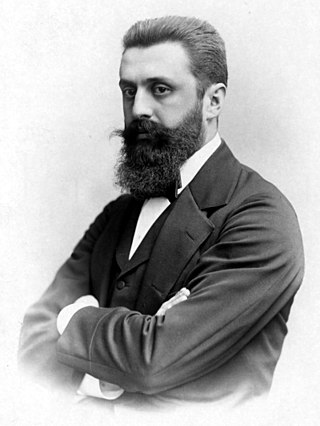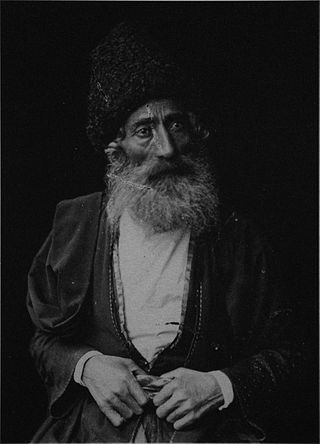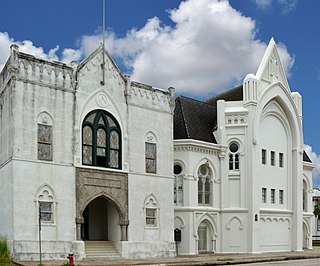Related Research Articles

Zionism is a nationalist movement that espouses the establishment of, and support for a homeland for the Jewish people centered in the area roughly corresponding to what is known in Jewish tradition as the Land of Israel on the basis of a long Jewish connection and attachment to that land.

Georgian Jews are a community of Jews who migrated to Georgia during the Babylonian captivity in the 6th century BCE. It is one of the oldest communities in that land.

Aliyah is the immigration of Jews from the diaspora to, historically, the geographical Land of Israel, which is in the modern era chiefly represented by the State of Israel. Traditionally described as "the act of going up", moving to the Land of Israel or "making aliyah" is one of the most basic tenets of Zionism. The opposite action—emigration by Jews from the Land of Israel—is referred to in the Hebrew language as yerida. The Law of Return that was passed by the Israeli parliament in 1950 gives all diaspora Jews, as well as their children and grandchildren, the right to relocate to Israel and acquire Israeli citizenship on the basis of connecting to their Jewish identity.

Israel Zangwill was a British author at the forefront of cultural Zionism during the 19th century, and was a close associate of Theodor Herzl. He later rejected the search for a Jewish homeland in Palestine and became the prime thinker behind the territorial movement.
The history of the Jews in Latin America began with conversos who joined the Spanish and Portuguese expeditions to the continents. The Alhambra Decree of 1492 led to the mass conversion of Spain's Jews to Catholicism and the expulsion of those who refused to do so. However, the vast majority of Conversos never made it to the New World and remained in Spain slowly assimilating to the dominant Catholic culture. This was due to the requirement by Spain's Blood Statutes to provide written documentation of Old Christian lineage to travel to the New World. However, the first Jews came with the first expedition of Christopher Columbus, including Rodrigo de Triana and Luis De Torres.
Yerida is emigration by Jews from the State of Israel. Yerida is the opposite of aliyah, which is immigration by Jews to Israel. Zionists are generally critical of the act of yerida and the term is somewhat derogatory. The emigration of non-Jewish Israelis is not included in the term.

The First Aliyah, also known as the agriculture Aliyah, was a major wave of Jewish immigration (aliyah) to Ottoman Syria between 1881 and 1903. Jews who migrated in this wave came mostly from Eastern Europe and from Yemen. An estimated 25,000 Jews immigrated. Many of the European Jewish immigrants during the late 19th-early 20th century period gave up after a few months and went back to their country of origin, often suffering from hunger and disease.

The Second Aliyah was an aliyah that took place between 1904 and 1914, during which approximately 35,000 Jews immigrated into Ottoman-ruled Palestine, mostly from the Russian Empire, some from Yemen.

Congregation B'nai Israel is a Jewish synagogue located in Galveston, Texas, USA. Organized by German Jewish immigrants in 1868, it is the oldest Jewish Reform congregation and the second chartered Jewish congregation in the state.

The Jewish Territorial Organisation, known as the ITO, was a Jewish political movement which first arose in 1903 in response to the British Uganda Offer, but which was institutionalized in 1905. Its main goal was to find an alternative territory to that of Palestine, which was preferred by the Zionist movement, for the creation of a Jewish homeland. The organization embraced what became known as Jewish Territorialism also known as Jewish Statism. The ITO was dissolved in 1925.

The history of the Jews in Mexico began in 1519 with the arrival of Conversos, often called Marranos or "Crypto-Jews", referring to those Jews forcibly converted to Catholicism and that then became subject to the Spanish Inquisition.

Henry Cohen was a British-American rabbi, scholar, community activist and writer who served most of his career at Congregation B'nai Israel in Galveston, Texas, from 1888 to 1949. He came to the United States in 1885, during a period of rapid and massive growth related to early 20th-century immigration from eastern and southern Europe. In Texas, he organized the Galveston Movement, which worked from 1907 to 1914 to attract eastern European Jewish immigrants to Galveston and the Gulf Coast as a destination, as an alternative to the better known Northeastern cities. Ten thousand such immigrants entered at Galveston.
Zionism as an organized movement is generally considered to have been founded by Theodor Herzl in 1897. However, the history of Zionism began earlier and is related to Judaism and Jewish history. The Hovevei Zion, or the Lovers of Zion, were responsible for the creation of 20 new Jewish towns in Palestine between 1870 and 1897.
Albert Montefiore Hyamson, was a British civil servant and historian who served as chief immigration officer in the British Mandate of Palestine from 1921 to 1934.

The Galveston Movement, also known as the Galveston Plan, was a U.S. immigration assistance program operated by several Jewish organizations between 1907 and 1914. The program diverted Jewish immigrants, fleeing Russia and eastern Europe, away from East Coast cities, particularly New York. During its operation, ten thousand Jewish immigrants passed through the port of Galveston, Texas, about a third the number that emigrated to Palestine during the same period. New York financier and philanthropist Jacob Schiff was the driving force behind the effort, which he supported with nearly $500,000 of his personal fortune. B'nai Israel's Rabbi Henry Cohen was the humanitarian face of the movement, meeting ships at the Galveston docks and helping guide the immigrants through the cumbersome arrival and distribution process, and on into the countryside.

The migration of Moroccan Jews to Israel has been made all over the centuries. Moroccan Jews in Israel have been the founders of many pioneer neighborhoods in Jerusalem, Tel Aviv, Haifa, Tiberias and others.

The history of the Jews in Chile dates back to the arrival of Europeans to the country. Over time, Chile has received several contingents of Jewish immigrants. Currently, the Jewish community in Chile comes mainly from the migrations occurred in the 19th and 20th centuries, mostly of Ashkenazi background.

The history of the Jews in Ecuador dates back to the 16th and 17th centuries, when Sephardic Jews began arriving from Spain and Portugal as a result of the Spanish Inquisition. Ecuadorian Jews are members of a small Jewish community in the territory of today's Ecuador, and they form one of the smallest Jewish communities in South America.

The history of the Jews in Peru begins with the arrival of migration flows from Europe, Near East and Northern Africa.
Morris David Waldman was a Slovakian-born Jewish-American rabbi and social worker.
References
- 1 2 3 4 5 6 7 "Guide to the Record of the Industrial Removal Office undated, 1899-1922". American Jewish Historical Society. Retrieved 2018-12-17.
- ↑ Cantor, Judith Levin. "Jews in Michigan (East Lansing, Mich.). Michigan State University Press, 2001. p. 45" . Retrieved 2023-07-07.
- 1 2 3 "Guide to the Records of the Jewish Immigrant Information Bureau (Galveston, Tex.). Galveston immigration plan records, undated 1901-1920". American Jewish Historical Society. Retrieved 2018-12-17.
- 1 2 "Israel Zangwill British Author and Zionist Leader". Encyclopaedia Britannica. Retrieved 2018-12-17.